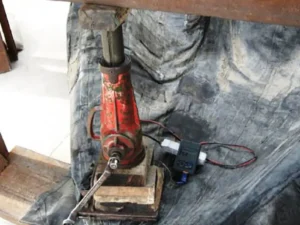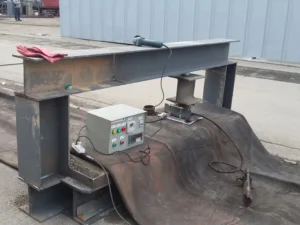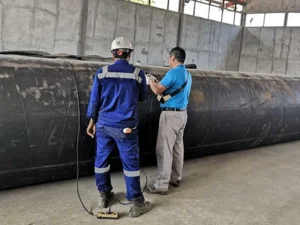Introduction
Extended use of a ship-launching airbag in the boating industry has raised standards. Everyday collision and accident cases have raised concerns for better security methods. Ship-launching airbags are one of the best options to offer safety to your boats when launching them in the water. Unfortunately, the marine airbag is not immune to the punctures or strains. In the launching process, they might get damaged, too. But you don’t have to fret anymore, as we have various ways to repair a ship-launching airbag. In this blog, we have listed step by step guide on restoring your airbags.
Repair Tools You need
Before you jump onto the DIY repair of your marine rubber airbag, you need to have the tools and materials. Once you have all the necessary tools, the game is on.
Here are key tools that assist in the excellent repair of your marine rubber airbags.
-
Angle grinder
An angle grinder is a tool that smooths the surface. It can remove the elevations and slopes to straighten up your airbag surface and make it excellent for repair.
-
Brush
Brush helps remove the dust or debris on the surface. It plays a crucial role in gasoline application on the surface as well.
-
Hydraulic jacks

Jack helps create a high pressure and apply it on the repair surface. Doing so provides the tangible adhesion of the rubber on the leaking surface and protects from recurrent leakages. You can set the temperature and pressure accordingly.
-
Steel plate and block
Steel plate works with the hydraulic jacks to provide the repairing applications. It presses the material against the heating plate in hydraulic jacks. Moreover, it acts as an additional support for the heating plate.
-
Brackets

Brackets provide support in pressing phenomena of hydraulic jacks.
-
Large needle with string
If there are large holes in the ship-launching airbag, large needles help stitch the surface and approximate the ends. There are no leaks when you sew the surface efficiently.
-
Sandbag
Sandbags help in the safe repair. Place them between the airbag and lying support and repair them quite effectively.
-
Heating plates
During the thermal vulcanization, heating plates help fix the place and provide quick adhesion. They make the surface leak-proof.
Necessary Material for repairing
There are some necessary materials for the repair.
-
Facing adhesive
It offers a better connection of the repairing rubber with the leakage places. Get a leak-proof with a quality adhesive.
-
Glue adhesive
Glue adhesive does the same thing as the facing. You can apply it on the surface and use the repair rubber patch.
-
Cleaning material
You might need the gasoline for the repair surface cleaning.
-
Cordage film
It reinforces the repair area to provide strength.
-
String
The string helps in stitching and repairing the repair surface.
5 Steps for Repairing a ship launching airbag
There are five key steps to repairing a ship-launching airbag. These include:
-
Step 1: Clean the Surface
First of all, clean the airbag surface. You can use the cleaning materials or soak it into the water. Make sure the soaking occurs within hours before you repair.
After cleaning the surface, dry well. Keep in mind a threshold of 10 minutes of soaking in the water, not more than that.
-
Step 2: Comprehensive Inspection

Remember. It is usual to miss the minor trauma points or leaks in the marine airbag for ship launching. That is why consider a detailed inspection. Check the upper, lower, and cornered surfaces. Don’t leave a single unchecked.
Suppose you have found the repair area; now it is time to mark it. You can take measurements in centimeters when measuring the total area of repairs.
-
Step 3: Rapuring of ship-launching airbag
Repairing occurs in various steps.
- Let the angle grinder clear up the surface where the damage has occurred. Expose the cords, but avoid damaging them.
- Have you found the cracks? Repair small cracks with simple stitch repairs. For larger cracks, you can use the sewing needles with a distance of 10cm between the stitches. Check the strength and ensure there are no weak points. Also, check if there is minimal leak still left to sew.
- After stitching, it is better to wash the surface. But use the gasoline this time for effective results.
- Now, you can apply the glue to the repair surface. It will act as an adhesive material and provide a better connection of the underlying surface with the overlying rubber you’ll place in the next step.
- Take measurements in different dimensions of the total damaged area you repaired. Cut the rubber to fasten it on the surface. Confirm whether the rubber is the same as the airbag material. Discrepancy in the material can cause recurrent repair.
- Place the rubber material on the surface and let the glue show its adhesion magic. Monitor for the leakages if any are left yet.
- You can make the permanent sealing with the two layers of interleaved and offset. It will guarantee a better setup and repair on the surface.
-
Step 4: Thermal Vulcanization process
The thermal process is a revolution for the better integrity of the material and leak repair. Keep a temperature controlled up to 150 ±5 °C for the vulcanization. Apply the maximum pressure using a jack.
Shut down your steel surface and let it cool up to 60°C. Keep the jack still on.
-
Step 5: Final Inspection
Are you sure there is no leakage? Let’s test it.
- Get a quick inspection of the repair area.
- Inflate the ship-launching airbag.
- Wait for a few moments to notice if there is spontaneous deflation due to a small leakage.
If everything looks fine, that is the first DIY repair of your ship-launching airbag.
How do you avoid damage to your ship-launching airbag?
You might think, why not remove the cause? Why even cause damage to the airbag? Is that possible to ensure safety in the long term?
Yes, that is possible with the following rules.
-
Don’t exceed the air pressure limit
Ship launching marine airbags protect the boats when casting them into the sea. This process isn’t simple because of the hundreds of tons of weight of a vessel. Ship-launching airbags can protect the ship while hurting themselves by absorbing energy.
Low pressure with inadequate filling damages your boat. On the other hand, high-pressure filling causes a tightness of the rubber airbags. An overfilled marine rubber airbag is more prone to damage. Keep the damage away by following the recommended pressure range with filling volume.
-
Do regular cleaning.
Without maintenance, your ship-launching airbags start deteriorating. Guess why? The simple logic is the collection of dust and debris on the surface. It decreases the surface efficiency and accepts minor trauma in the form of large holes.
Regular cleaning guarantees a long life. It ensures the material remains clean and avoids any damage due to dust particles. Moreover, it retains the new-like performance for extended periods.
-
Avoid dragging your airbags
Dragging your airbags on a surface has various reasons for damage.
- There may be sharp objects lying on the ground. Dragging can bring up holes in the surface.
- Friction due to dragging decreases the rubber’s life and makes it vulnerable to damage. Ultimately, you need to repair it.
So, how do you avoid this damage?
Whenever you are transporting the airbags, take extreme care. Roll them instead of dragging them. Use a smooth and soft surface on which you roll the airbags. Don’t exert extra pressure when moving.
-
Store in a safe place
Ship-launching bags are crucial when launching the ship. Not every time you need it. There are various storage tips.
- Clean your airbags and dry them well before storage.
- Have a safe place with an adjustable room temperature.
- Don’t expose them to the sunlight or store them in a place that accepts sunlight.
- Avoid extremes of temperatures in the place.
- Observe the airbags from time to time to check if there is any trauma.
- Regular maintenance is necessary even if you do not use the airbags anymore.
Always handle the storage process professionally and embrace the manufacturer’s instructions for safe storage.
-
Avoid contact with sharp objects
Not just the dragging brings contact with blunt materials or sharp objects like knives. Instead, during the ship’s launching, there might be some direct objects lying on the surface.
You can avoid it quite effectively. Check the area when launching the ships. Look for any blunt metals and remove them from the surface. Launch your boats and check if any trauma has occurred. Small repairs on time keep you safe from big repairs that need the skills of professionals.
Conclusion
The first thing is no damage. Buy a quality airbag with excellent and immune material. Don’t let the sharp objects bring up holes in your airbags.
But where do you get a quality ship-launching airbag manufacturer, then? Jerry Borg Marine has the best quality marine airbags. Quick access, guaranteed long-lasting life, and best prices. Grab it now!
